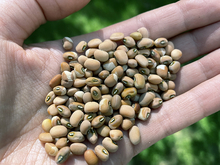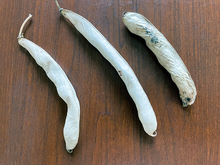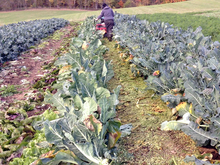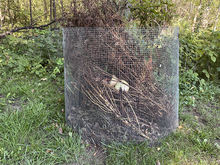Fall is an abundant and satisfying season in the garden. Your hard work throughout the season has produced a wide variety of fruits and vegetables. Flowers continue to bloom, and the cool nights are allowing cool season vegetables to flourish.
At this point in the season, there are a few things left to do to help transition your garden to winter, and to prepare for next season.
Saving seed
Seed saving is one of the things I look forward to most in the fall. There are many important reasons to save seed including adapting varieties to local conditions, connecting with your neighbors and friends via seed swaps, preserving plants that have been in your family for generations, and saving money by not needing to buy new seeds each year.
Dry seeds are the easiest to save. These include things like beans, corn, and many flower seeds, which dry on the plant and can simply be removed. Wet seeds, like tomatoes and cucumbers, require a bit more finesse as they must be fermented for a couple of days to break down the gelatinous seed coating. Here’s a quick guide to wet seed processing and selling from Growing for Market.
Save open pollinated seeds
- Seed from open pollinated varieties should produce plants that are similar to the plants you saved seed from.
- Seed from hybrid varieties will not.
- Most backyard gardeners should stick to open pollinated seeds.
Save seed only from healthy plants
- Many diseases can be carried on seed, so it’s best to start with the healthiest seed possible.
- Hot water treatment can help to reduce disease carry-over from year to year, but it is not a substitute for starting with clean, healthy seed.
Save seed from as many plants as possible
- If you just have a few plants in a small garden, it’s fine to save seed for yourself. But, the more plants you can include, the more genetic diversity you end up with.
- This is important for long-term seed preservation, and to make sure that the varieties you’re saving remain consistent over time.
- Also, with a large enough population, you can begin to select for traits you like such as flavor, disease resistance, or yield.
Think about cross-pollination
- If you have two varieties of sweet corn next to each other, they are likely to cross-pollinate and produce a hybrid.
- Some plants like beans can be planted only 10-20 feet apart from other bean varieties to avoid cross-pollination.
- Others, like sweet corn, need up to half a mile between varieties.
Seed Savers Exchange has an excellent guide to seed saving that tells you how many individual plants you should save seed from in order to maintain a variety, and how far apart your plants need to be from similar plants (such as the distance between two separate varieties of sweet corn).
Many gardeners do not quite have the acreage needed to achieve these recommendations. Do your best, and you can always purchase new seed if you start to see problems with your saved seed.
You can also coordinate with neighbors and friends if there are varieties that you would all like to grow. By pooling your seed at the end of the year, you can increase the genetic diversity of your seed collection.
Take care of your soil
Fall is an important time to invest in your soil. If you have already harvested some of your garden plants like beans, sweet corn, or carrots and you have an open space in your garden, consider planting a cover crop. Cover crops can help to prevent erosion, they add or retain nutrients in your soil, they add organic matter, and can provide a whole suite of additional benefits to your soil.
A great option for backyard gardeners in the fall is a mix of oats and peas. If planted in early fall, they will grow throughout the fall and die over the winter. In most cases, they should naturally break down throughout the spring, leaving you with a nice seedbed in the spring for your next round of vegetables.
Read more about cover crop options for gardeners.
What to do with all of those residues?
At this point in the season, you’re likely finding yourself with a lot of residues in your garden. What’s the best thing to do with corn stalks or dried up bean plants once you’ve harvested the cobs and pods? You have a couple of options, all with pros and cons.
Work them into the soil
For many gardeners, fall clean up looks like taking a tiller out to the garden and tilling everything back into the soil.
Benefits of this approach include:
- Nutrients and organic matter in the residues are returned to the soil, which helps to build organic matter and recycle nutrients.
- Tilling chops residues into smaller pieces, and makes them more available to soil microbes. This helps the residues break down quickly, and also helps to break down plant diseases that may be present in the residues.
Some downsides of this approach include:
- Tillage is harmful to soil structure in the long-term
- If you do this without planting a cover crop afterwards, the soil is bare throughout the winter, making it more vulnerable to erosion.
Leave them on the soil surface
One option is to simply leave residues in the garden without tilling them in. Ideally, this option would include some method of chopping or cutting residues into smaller pieces to help them break down more quickly. This can be done with equipment such as a flail mower, or with more low-tech methods like a scythe or pruning shears.
Benefits:
- Nutrients and organic matter in the residues are returned to the soil, which helps to build organic matter and recycle nutrients.
- This approach avoids tillage, which is harmful to soil in the long-term.
Downsides:
- Chopping residues by hand may be time-consuming
- Residues will take longer to break down on the surface vs. if they were tilled into the soil
Remove residues and compost them
Removing residues can be convenient if you have a compost bin nearby that can handle a large amount of biomass. Make sure to turn it regularly and add a balanced mix of green and brown materials.
Benefits:
- A clean planting surface for fall greens or cover crops.
- Removing residues may help to prevent diseases on plant residues from overwintering in the soil.
Downsides:
- Residues are an important reservoir for nutrients, and they are a source of organic matter. By removing them, you actively remove nutrients and organic matter from your system.
- If you compost your residues, you can add the compost back to your soil to mitigate this.
Read more about composting in home gardens.






